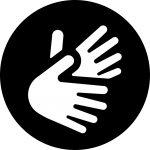
The Accessibility Interface
Dr. Ware’s interface is a session-based design and UI adjustment tool that makes accessibility modifications based on a user’s individual needs. All adjustments are compliant with WCAG 2.1 AA & AAA requirements.
AI-Powered Processes
Dr. Ware’s AI machine learning technology uses contextual understanding and computer vision to address the complex, back-end requirements needed for screen reader and keyboard navigation adjustments.
Here’s how it works
Dr. Ware utilizes two applications that together achieve full compliance. The accessibility interface is responsible for all the UI and design-related adjustments, while the AI-powered background process handles the more complex requirements – optimization for screen-readers and for keyboard navigation.
Closed Captions
Closed captions are a text version of what is said vocally and are used by users with hearing impairments to follow the content.
Video/Audio Transcripts
Transcripts are a separate textual version of a video/audio for users who may have a hard time following live content.
Audio Descriptions
Audio descriptions enable blind users to follow videos where graphics are used to display the information rather than voice.
Whether you incorporate downloadable files within your website, send them over email, or use them internally, they should be accessible!
Word/PDF Remediation
Documents should be accessible for blind users using screen-readers and can vary in complexity depending on the content.
PPT Remediation
Presentations are a great way to deliver information. Let’s ensure that blind users have the opportunity to get that information as well!
Excel Remediation
Excel sheets often include highly important information. Let’s ensure that everybody, regardless of abilities, can read and understand them!
Disabilities that Dr. Ware Covers
We enable website owners to serve users with a wide array of disabilities all in adherence to the WCAG 2.1 and worldwide legislation
- Blind
- Motor Impaired
- Cognitive Disorder
- Epileptics
- Vision Impaired
- Hearing Impaired
What is the web accessibility legislation?
Due to the increased use of the Internet, many countries have incorporated web accessibility into existing civil rights legislation that protects people with disabilities or created new ones.
This includes the ADA, AODA, EEA, and many more. Most countries have adopted the WCAG 2.1 AA, or Web Content Accessibility Guidelines, as standard for accessible websites and refer to them in settlements.
How does legislation impact my website?
In 2018, the DOJ clarified that websites are considered places of public accommodation and should therefore comply with the ADA Title III. US courts refer to WCAG 2.1 AA as the accessibility standard
Why should I care about the WCAG?
WCAG stands for the Web Content Accessibility Guidelines. They are the most important guidelines for web accessibility policy and set the standard for web accessibility legislation in most countries around the world.
To really understand why the WCAG matters so much, you need to know who is behind them. The WCAG was created by the World Wide Web Consortium, known as the W3C. The W3C was founded in October 1994 in the halls of MIT’s Laboratory for Computer Science (MIT/LCS), when global web activity started soaring. Founding members included top scientists, and by late 2019, the organization has over 440 members including leaders from business, nonprofit organizations, universities, government entities, and relevant industries.
W3C’s originally focused on standardizing web protocols so that websites and web tools would be compatible with each other. Every W3C standard is reviewed several times, tested, and analyzed before it’s approved by members. Usually, W3C standards have 3 levels of compliance, from A to AAA.
Web accessibility was one of the earliest issues that W3C addressed. The first WCAG was published in 1999, but it was revised in 2008 as WCAG 2.0 and updated again in 2018 in the form we use today.

